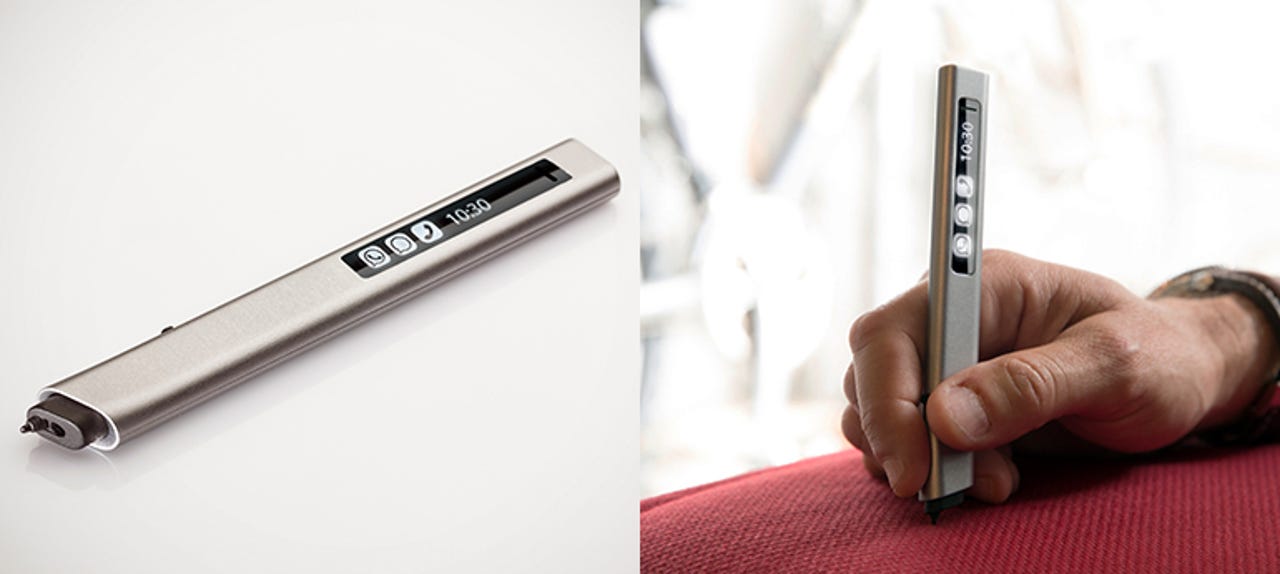Phree: The Bluetooth pen that writes on almost any surface

The pen is a natural input device for many people, but as mobile devices become ever more capable, a problem becomes increasingly evident: it's inconvenient to use a stylus with small-screen devices like smartphones, phablets, and 7-8-inch tablets.
Next year, if its KickStarter project comes to fruition, Israeli startup OTM Technologies will market a stylus with a difference: it's called Phree, and it allows you to write on almost any surface within Bluetooth range of your device, displaying the resulting input on-screen. Furthermore, with Phree you'll be able to answer calls (it has a speaker and a headset jack) and interact with notifications (it has an OLED touch-screen) -- answering a text message by writing on the back of your hand, for example.

The key to Phree's operation is OTM Technologies' patented optical translation measurement technology: "What we invented," co-CEO Gilad Lederer told ZDNet, "is a way to measure laser doppler in three dimensions." The sensor uses the same 850nm laser as optical mice, measuring the interference between the projected beam and reflections from the surface. The optically extracted motion signal is then translated into x-y-z information by signal-processing algorithms on the pen's 8mm by 8mm by 16mm integrated sensor unit.
The key advantage of this laser doppler/diffraction technology is that the sensor continues to track the pen tip's motion even when it's lifted (by up to about 2.5cm) from the surface, thereby allowing the precise characteristics of your handwriting to be captured (biometric identification via your signature is another use for Phree). "There is no other technology in the world that can do this without some kind of external reference," said Lederer. "If you can see it, if it reflects light, we can measure it."
As computing moves to smaller-screened mobile devices, the appeal of a technology that doesn't need to write directly on the screen increases greatly. The KickStarter population certainly seems to think so: at the time of writing, with 18 days to go, the Phree campaign has exceeded its $100,000 goal by more than seven times.
Phree works with most third-party apps on Android, OS X and Windows devices -- whether they have touchscreens or not. Compatibility with iPhones and iPads is problematic because iOS does not display a cursor or support cursor control: however, Lederer said that OTM Technologies intends to create a dedicated iOS app and will release an SDK ahead of production shipments of Phree so that developers can optimise their apps.
As well as the Phree itself - which measures 142mm by 18mm by 8.5mm and weighs 30g - the company has cleverly designed a case that not only supports wireless charging for the Bluetooth pen, but also converts into a stand for your smartphone. The pen's battery lasts for around a week and takes about an hour to recharge, according to OTM Technologies.
The Phree KickStarter campaign ends on 26 June, after which the company will concentrate on shrinking today's prototype development boards to fit the product's industrial design. Testing is scheduled for November 2015 to January 2016, with manufacturing starting in February and shipping in March. The device is expected to cost $199.
OTM Technologies' Lederer is, naturally, bullish about Phree's prospects, noting that, "Now, with wearables, the Internet of Things, smart home, virtual reality... suddenly you have a proliferation of devices with various ways to load you with information -- but a lot of them are very limited in the way you interact with them."
Not only that, but with DirectInk support slated for all universal apps in Windows 10 and handwriting input now supported for any Android app via Google Handwriting Input, the wind is clearly blowing the way of widespread pen-driven computing.
We look forward to a full hands-on review of Phree once it ships next year.
Read more